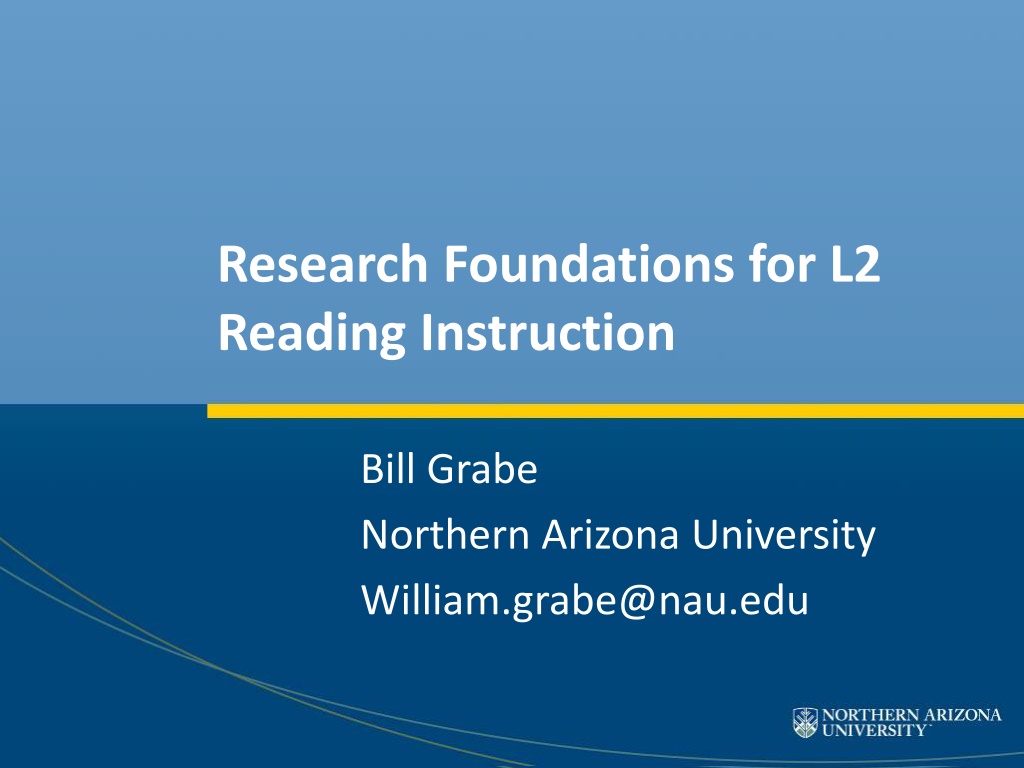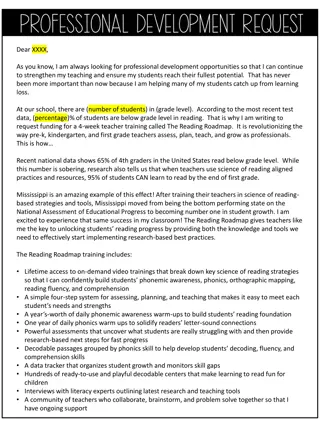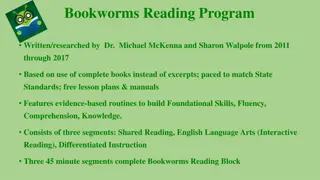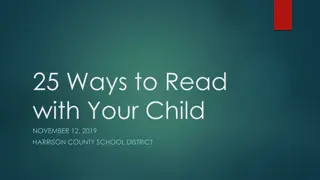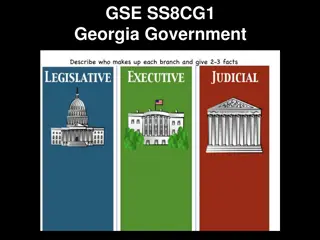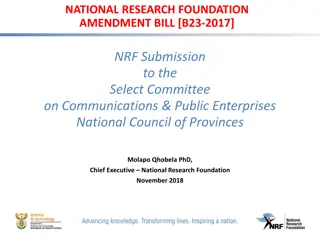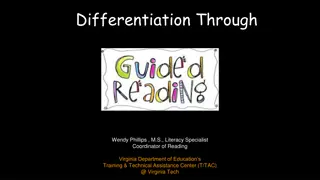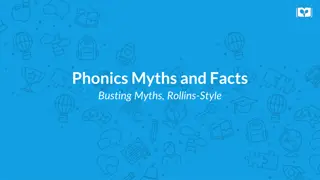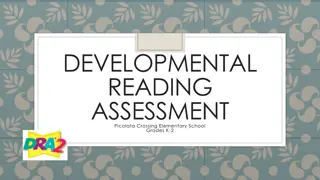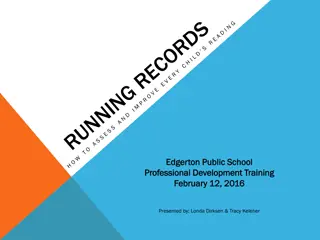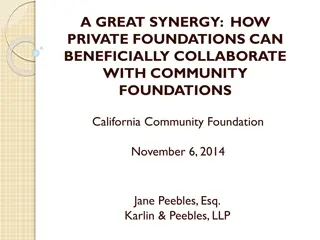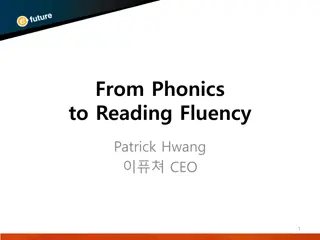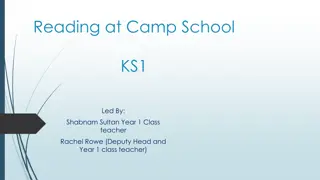Research Foundations for L2 Reading Instruction by Bill Grabe
This research by Bill Grabe from Northern Arizona University delves into the cognitive foundations of L2 reading instruction. It explores key concepts such as the miracle of reading, defining reading, reading processes, and the importance of having a good coach for developing reading expertise in both L1 and L2 contexts.
Download Presentation

Please find below an Image/Link to download the presentation.
The content on the website is provided AS IS for your information and personal use only. It may not be sold, licensed, or shared on other websites without obtaining consent from the author. Download presentation by click this link. If you encounter any issues during the download, it is possible that the publisher has removed the file from their server.
E N D
Presentation Transcript
Research Foundations for L2 Reading Instruction Bill Grabe Northern Arizona University William.grabe@nau.edu
Introduction 1. 2. 3. The miracle of reading Defining reading and cognitive foundations The reading construct as the goal for the development of reading abilities Expertise and reading: Get a good coach L1 and L2 Reading Implications from research for instruction Key research-based instruction ideas 4. 5. 6. 7.
The Miracle of Reading 1. Reading is not genetically wired and every person must learn to read with someone s help 2. We learn to process reading faster than listening 3. During fluent reading, we recognize words on average in about 230 msec., about 5 WPS 4. Two seconds of reading (handout) 5. It is miraculous; more than 89% of humans learn to read, and many can do it in a second language
Defining Reading 1. Most definitions of reading comprehension are similar but they do not say enough 2. Reading is a complex cognitive process 3. Component skills include rapid word recognition, a large recognition vocabulary syntactic processing, strategic processing, main idea recognition, fluent processing, and use of general cognitive resources.
Reading Processes: General Cognitive Skills 1. Working memory 2. Background knowledge 3. Inductive, implicit learning mechanism, associational learning, statistical learning 4. Cognitive processing speed 5. Inhibitory suppression mechanism 6. Selective attention and shifting mechanisms 7. Inferencing, monitoring , and goal setting abilities 8. Capacity for motivation to learn
Reading Processes: Lower and higher Level Processes Lower level processes: Word recognition, lexico- syntactic processing, semantic processing Higher level processing: form main and supporting ideas, build a text model of comprehension, a situation model od reader interpretation, and a documents model All in working memory and a bit more (wherever that is)
Get a Good Coach 1. Reading in academic contexts requires reading expertise 2. Expertise requires a coach/teacher, many hours of experience, and deliberate practice 3. Concept of deliberate practice has many similarities with work of athletic trainers 4. Deliberate practice develops better mental representations, and new knowledge resources (see handout)
L1 L2 Differences 1. 2. 3. 4. 5. 6. 7. L2 reading is even more complex A much smaller L2 linguistic knowledge base Much less experience with L2 reading exposure Cognitive processing involving two languages A range of L1 transfer effects Differing combinations of background knowledge Distinct L2 social and cultural assumptions
L1 L2 Similarities 1. 2. 3. 4. Same underlying cognitive processes More similar as proficiency increases More similar with closer L1/L2 linguistic distance More similar as higher level cognitive processes are called on (for challenging but appropriate academic tasks) Multiple processing paths to comprehension is true even within L1 groups of readers 5.
L2 Meta-analysis Melby-Lervag, M., & Lervag, A. (2014). Reading comprehension and its underlying components in second- language learners: A meta-analysis of studies comparing first-and second-language learners. Psychological Bulletin, 140(2), 409-433. 82 studies, 576 effect sizes, 15,137 learners, 8 moderator variables, 1980 to 2011. L2 learners: medium sized deficit in reading comp (d=-.62) L2 large deficit in language comp (d=-1.12) L2 minimal deficits in decoding and phonological aware.
L2 meta-analysis (2) Jeon, E.-H., & Yamashita, J. (2014). L2 reading comprehension and its correlates: A Meta-analysis. Language Learning, 64(1), 160-212. Reading comp, 10 component variables, 4 moderator var. 59 studies, 67 independent samples, 9,461 learners, 1979- 2011 R sq. vocab 62%, r sq. grammar 72%, decoding 31%, orthographic know. r sq. 25%. Morphological know. 37% Vocab shared variance much stronger with older learners Listening comp. r sq. 59%
L2 Reading, L2 Language, L1 Reading Yamashita, J., & Shiotsu, T. (2017). Comprehension and knowledge components that predict L2 reading: A latent-trait approach. Applied Linguistics, 38(1), 43-67. Latent trait analysis with Rasch scores and SEM 325 English L2 Japanese univ. students Variables: L1 reading, L2 listening, L2 vocab-grammar combination (L2 knowledge) Full sample: r. sq of 94% between L2 reading and L2 listening and L2 knowledge. L1 Reading was negligible More advanced students: L1 reading emerged as a weak 3rd predictor.
Discourse Structure Awareness: Graphic Organizers Jiang, X. (2012). Effects of discourse structure graphic organizers on EFL reading comprehension. Reading in a Foreign Language, 24(1), 84-105. 16 week training with DSGOs with freshmen (174) and sophomores (166) in reading course at Shanghai Univ.: 179 experimental and 161 control 75% of course exactly the same, treatment classes had 25% time working with DSGOs for texts in the required textbook. DSGO test showed a strong effect (Cohen d .82), TOEFL RC showed small gain (Cohen d .34) Grammar: treatment did signif. better on unit texts by end.
Extensive Reading as Effective Add- on Robb, T., & Kano, M. (2013). Effective extensive reading outside the classroom: A large-scale experiment. Reading in a Foreign Language, 25(2), 234-247 All Students at Kyoto Sangyo University for 2008 (2,797) and for 2009 (2,200). University implemented university ER at home for 2009. Students read 5 graded readers for full credit. 2009 year students in all disciplines significantly improved in reading comprehension and most improved in listening Success due to additive homework, well stocked central library, M-reader accounting, central admin support.
Extensive Reading Training Improves Reading Suk, N. (2017).The effects of extensive reading on reading comprehension, reading rate, and vocabulary acquisition. Reading Research Quarterly, 52(1), 73-89 171 English L2 Korean University students: 83 experimental (2 classes) and 88 control (2 classes). 70% of curriculum was the same; 30% in experimental was ER time. Treatment sig. better for reading comp (d =.30), rate (d=.39), and vocab (d=.70). ER can be incorporated into EFL university classes and achieve better results while still using required textbook.
Seven Implications for Teaching L2 Reading 1. Build a large recognition Vocabulary 2. Develop main idea comprehension skills 3. Teach discourse structure awareness 4. Develop reading fluency 5. Develop the strategic reader 6. Require extensive reading 7. Integrate language and content instruction
Trans Fats in Trouble (From Anderson, 2008) Read the text for 2-3 minutes to prepare for a set of tasks.
Build a Large Recognition Vocabulary 1. 2. Practice using large numbers of words Create a vocabulary rich environment to support learning Build student awareness of words Help students collect words Build motivation for word learning Recycle texts and vocabulary Require extensive reading 3. 4. 5. 6. 7.
Build a Large Recognition Vocabulary 1. 2. Select a small number of key words (5-8 words) Note 30-50 words from a text to use for vocabulary practice activities Gloss uncommon words (fuss: attention) 3.
30-50 Words to Practice ruled out attributed to process a greater chancelinked to proven requires Forced mandatory ban Adhere to staples medical study flavor texture chemically changed the addition of controlling cancer to alert health conditions created heating correlating heart disease obesity restrict labeling resulting validating
Use Large Sets of Words Working with large sets of words provides a vocabulary rich environment to support learning Sorting Using continua
Use Large Sets of Words Based on the text, sort words into 3 categories (problems, processes, solutions): attributed to process greater chance proven requires health conditions restrict mandatory ban adhere to medical study the addition of linked to heart disease changed allowed intrude into controlling eliminate correlating forced choice heating obesity created resulting strict rules
Use Large Sets of Words Here is one possible set of answers based on the text (problems, processes, solutions [regulations]): attributed to medical study linked to proven greater chance health conditions correlating heart disease obesity process the addition of created heating resulting changed restrict requires intrude into allowed ban controlling eliminate strict rules forced adhere to mandatory choice
Use Large Sets of Words Sort solution (regulation) words along the continuum below Minimal control control Maximal adhere to, allow, ban, eliminate, willing, forced, mandatory, voluntarily, control, not intrude into, restrict, choice
Use Large Sets of Words Sort solution (control) words along the continuum below eliminate willing Minimal control Maximal control adhere to, allow, ban, eliminate, willing, forced, mandatory voluntarily, control, not intrude into, restrict, choice
Use Large Sets of Words Sort solution (control) words along the continuum below not intrude into mandatory voluntarily adhere to eliminate control restrict choice forced willing allow ban Minimal control Maximal control
Practice Comprehension Skills 1. 2. 3. 4. Activities that activate background knowledge Activities to identify main ideas in the text Strategic processing with more difficult texts Discussions about text information (questions on how to understand the text) Extensive reading 5.
Practice Comprehension Skills Identify main idea sentences
Identifying Main Idea Sentences Here are my answers: Paragraph 1 sentence 3 Paragraph 2 sentence 1 Paragraph 3 sentence 1 Paragraph 4 sentence 1 Paragraph 5 sentence 1 (?)
Build Awareness of Text Structure 1. Preview texts and highlight key words that signal text structure Highlight a paragraph; decide its function in the text Fill in an outline of the text and determine main units of the text Fill in a table, chart, graph, timeline, tree, graphic organizer, etc. Find patterns of discourse organization in a text (cause- effect, comparison-contrast) Reorganize scrambled paragraphs and sentences to reassemble a text or to make a good summary 2. 3. 4. 5. 6.
Build Awareness of Text Structure A text example: Trans Fats in Trouble
Build Awareness of Text Structure Problem (para 1) Solutions (para 3-5) 1. 2. Foods labeled for TF: Canada, US 3. 4. City voluntarily eliminates TF: Tiburon, CA 5. Trans fats (TF) affect health (para 1)
Build Awareness of Text Structure Problem (para 1) Solutions (para 3-5) 1. Countries restrict TF: Denmark, Canada 2. Foods labeled for TF: Canada, US 3. City requires ban on TF in restaurant NYC 4. City voluntarily eliminates TF: Tiburon, CA 5. States ban TF: CA, MA, MD, VT Trans fats affect health (para 1)
Practicing Passage Reading Fluency 1. 2. Reread texts used in class for multiple purposes Read silently with the teacher as the teacher reads aloud Use timed reading activities Engage in rereading practice (recycling) with a text used for a class unit Incorporate extensive reading 3. 4. 5.
Becoming a Strategic Reading 1. 2. 3. 4. Plan and form goals before reading Reread as appropriate Monitor reading continuously Use text structure information to guide understanding Build main idea summaries Evaluate the text and the author Attempt to resolve difficulties 5. 6. 7.
Teaching Strategic Reading 1. Introduce a strategy, talk about how, when, and why to use it. Add strategy to a class list Verbalize strategies in combination so students see strategies being used Model strategic reading, provide scaffolding, give extensive practice Focus comprehension discussions and questions on how to understand the text Promote comprehension monitoring Include strategy instruction as a part of everyday instruction, and not separate lessons 2. 3. 5. 6. 7.
Developing Extensive Reading 1. Provide as many attractive reading materials as is feasible Provide time for free reading in class (ScSR) Explain goals of extensive reading and long term benefits of extensive reading Integrate extensive reading in reading courses Create many opportunities for all kinds of reading Have a good graded-reader collection in the school or classroom library Find out what students like to read and why 2. 3. 4. 5. 6. 7.
Language & Content Learning for Reading Development 1. Teach component skills for reading within an integrated coherent curriculum Create opportunities for extended reading and recycling of prior texts in class Hold students responsible for language and content learning Create increasingly complex tasks; growing challenges to match growing skill Incorporate project-based learning Generate needs to interpret and evaluate information from multiple texts (good EAP tasks) 2. 3. 4. 5. 6.
Research Foundations for L2 Reading Instruction Bill Grabe Northern Arizona University William.grabe@nau.edu
